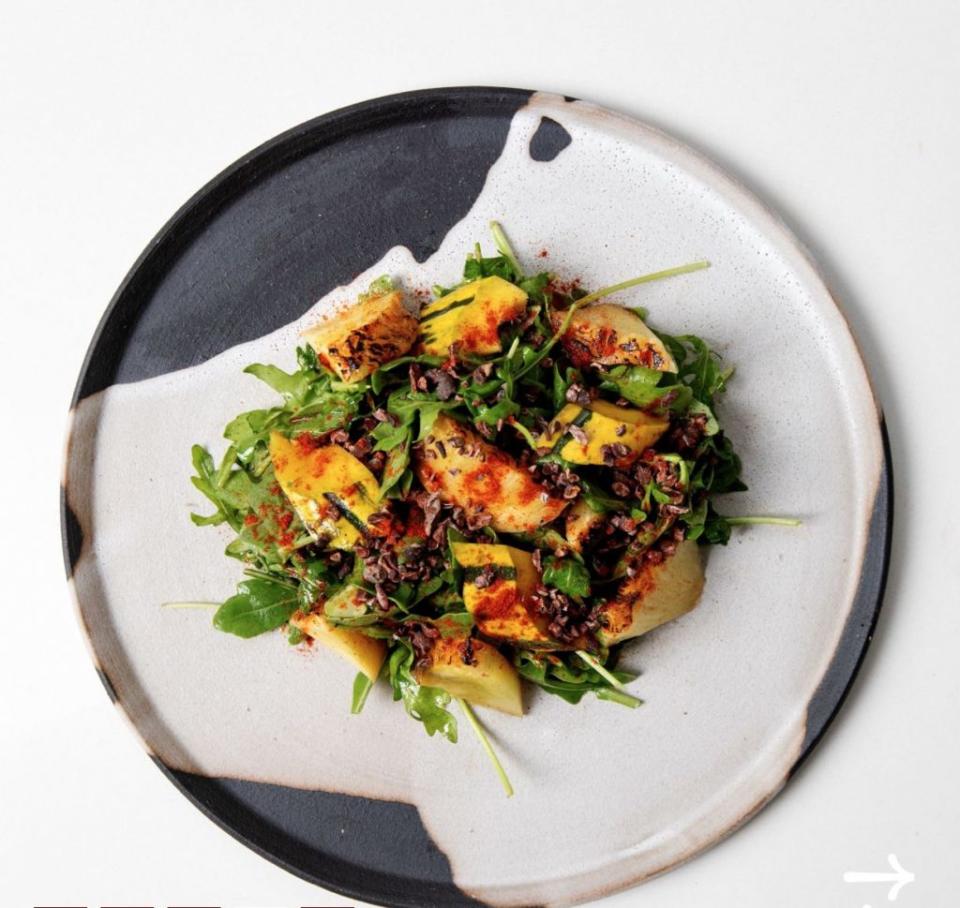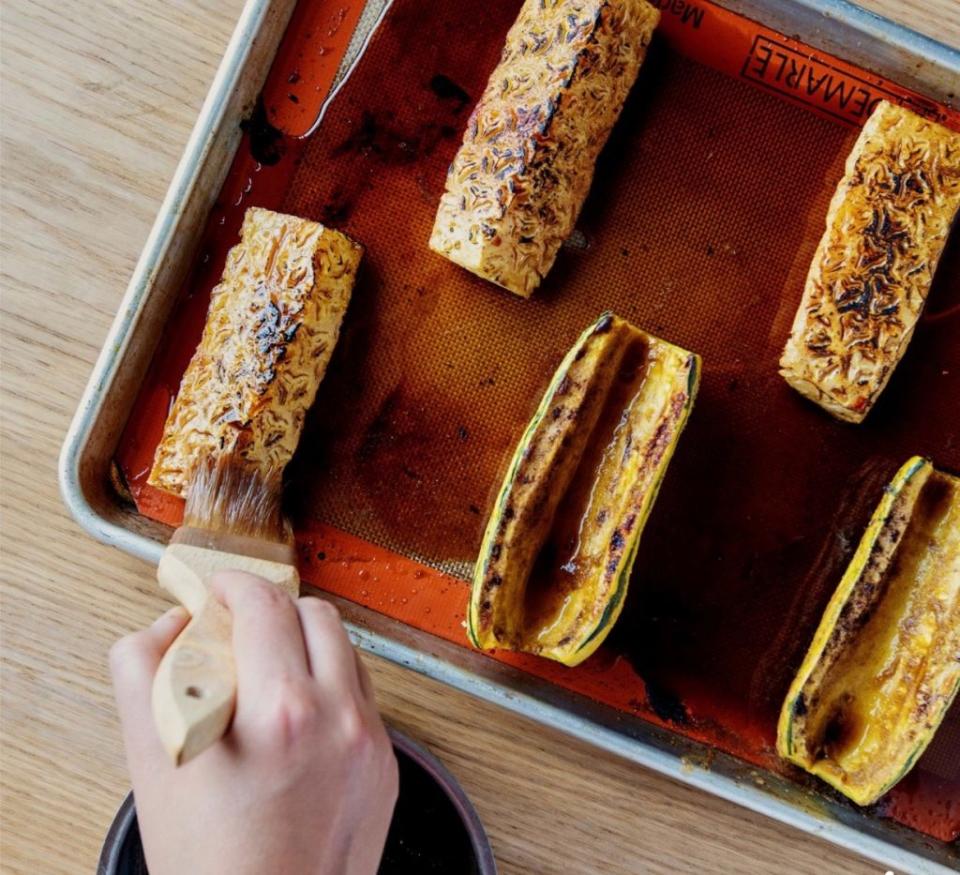A comprehensive guide for putting together a natural postpartum recovery diet

Adriana Urbina is an In The Know cooking contributor. Follow her on Instagram and visit her website for more.
The postpartum phase is not a time for restriction, deprivation or elimination, especially when breastfeeding. During this time, you need to be consuming enough calories to account for what you’re giving out, and you have to consider that proper postpartum nutrition is vital for both physical and mental health. You can utilize food strategically to balance your hormones, mood and energy levels, but with so much information out there, it can get a little overwhelming when deciding exactly what you should be eating.
For me, it has been very helpful to focus on three things: Reducing my consumption of processed foods, balancing my blood sugar and eating foods that reduce inflammation.

Below, we’ll dive into why it’s so important to care for your body post-pregnancy and why you should focus on anti-inflammatory foods, among other important nutrients. I’ll give you a full checklist of foods you can focus on eating. At the bottom of the page, you’ll find one of my favorite fall salads that accounts for some of the above goals.
Balancing your blood sugar:
The simplest approach to keeping your blood sugar balanced is:
Eat every three hours or so
Prioritize fiber-rich foods (focus on whole plant foods)
Avoid refined sugar
Eating anti-inflammatory foods:
Since your post-birth goals are to heal your body, rebuild your tissues, protect your mental health, produce nutrient-rich breast milk (for those who breastfeed) and restore your nutrient levels, anti-inflammatory foods should be the cornerstone of your diet. Consider adding the following anti-inflammatory foods to your diet:
Probiotic-rich foods like yogurt, kefir, kimchi, kombucha and sauerkraut
A wide variety of fresh, colorful vegetables (especially leafy greens)
Fruits and berries
Iron-rich proteins like grass-fed beef, buffalo, lamb, bison, liver and bone broths
Healthy fats like coconut oil, avocado oil, extra-virgin olive oil and pasture-raised butter
Fatty, low-mercury fish like wild-caught salmon and sardines
Moderate amounts of gluten-free, nutrient-rich grains like rice, millet, quinoa, oats, etc.
You should also consider reducing your consumption of sugar, caffeine and alcohol while increasing your consumption of the following:
Antioxidant-rich foods like berries, leafy greens, cauliflower, cacao, pecans, etc.
Omega-3-rich foods like hemp, chia seeds, flaxseeds, pumpkin seeds, walnuts, salmon, etc.
Spices like turmeric and ginger
Grocery list checklist:
To simplify things, here are my favorite inflammation-fighting, nutrient-dense foods for your snacks and meals. Bookmark this one and keep it handy for your next trip to the grocery store.
Vegetables:
Avocado
Bell peppers
Broccoli
Brussels sprouts
Carrots
Leafy greens like spinach, Swiss chard and kale
Potatoes
Red and green cabbage
Snow peas
Sweet potato
Fruits:
Bananas
Berries
Citrus fruits
Cranberries
Guava
Kiwi
Papaya
Pineapple
Proteins:
Albacore tuna
Beef
Beef liver
Black beans
Black-eyed peas
Chicken (bone-in)
Chickpeas
Cod
Collagen
Eggs
Lamb
Lentils
Mackerel
Sardines
Shrimp
Turkey breast
Wild-caught Alaskan salmon
Healthy fats:
Avocados/avocado oil
Coconut oil
Extra-virgin olive oil
Pastured butter
Nuts and seeds:
Almonds
Brazil nuts
Chia seeds
Flaxseeds
Macadamia nuts
Pistachios
Pumpkin seeds
Sunflower seeds
Walnuts
Miscellaneous healing foods:
Bone broth
Cocoa
Cultured foods such as yogurt, kefir, kimchi, sauerkraut
Dark chocolate
Gelatin
Hydrolyzed collagen
Sea vegetables
Spirulina
Herbs and spices
Anti-Inflammatory Crunchy Squash
and Pineapple Salad

This is one of my favorite fall salads to make. Mixing pineapple and squash, which have such different seasonal associations, creates a really surprising flavor mixture. It’s sweet, sour, full of spice, a little bitter and has an almost meaty aroma from the grilled fruit. So simple, so delicious and totally unique. Feel free to add any proteins you like or simply eat it as a side dish.
Ingredients:
Spices
1 teaspoon (2 pods) Ceylon cinnamon
1 teaspoon (2 pods) allspice berries
1 teaspoon (2 pods) allspice powder
1 teaspoon (2 pods) smoked paprika
Produce
Half a whole pineapple
2 pounds whole squash, either Delicata or Kabocha
5 garlic cloves, divided
8-9 ounces (or 240 grams) salad greens such as watercress, arugula or mixed
Pantry items
1 cup brown sugar
2 teaspoons salt, divided
1 tablespoon olive oil, for the squash
1 cup extra virgin oil, for the vinaigrette, plus more for garnish
1 cup cider vinegar
1/3 cup toasted green pumpkin seeds or sunflower seeds
1 tablespoon cacao nibs
Instructions:
Prep
1. Core and peel the pineapple and cut it in half. Peel and seed the squash and cut it in half.
2. To make the brown sugar simple syrup, combine the brown sugar with 1 cup of water in a small saucepan and heat it until it boils. Immediately remove it from heat and let it cool. Divide the mixture into 1 cup for the pineapple and 2 tablespoons for the vinaigrette, then set it aside.
3. Mince one garlic clove and set aside. Mash four garlic cloves and set aside.
Cooking the pineapple
4. Preheat your oven to broil, on high.
5. Place the pineapple on a baking sheet. Take the cup of brown sugar simple syrup and brush about half of it onto one side of the pineapple. Broil the pineapple about 4 inches from the heat source for around 8 minutes. Remove the pineapple from the oven, brush the other side with the remainder of the cup of simple syrup and return to broil for 8 more minutes. Remove the pineapple from the oven and slice it into horizontal strips (cutting with the grain) and set aside.
Cooking the squash
6. In a bowl, combine cinnamon, allspice berry, 2 teaspoons of salt and your minced garlic clove with 1 tablespoon of olive oil. Add the squash to the bowl and coat it with the mixture.
7. Place the squash on a baking sheet and broil about 4 inches from the heat source for 8 minutes. Remove the squash from the oven, turn over the squash and return to broil for 8 more minutes. Remove the squash from the oven, cut it into long strips and set aside.

Making the vinaigrette
8. Whisk together the mashed garlic cloves, ground allspice, 1 teaspoon of salt, 2 tablespoons of brown sugar simple syrup, 1 cup olive oil and cider vinegar.
Combine and plate
9. In a large bowl, toss the pineapple and squash strips with the vinaigrette and toasted pumpkin seeds. Add a generous handful of salad greens to each plate and place a few strips each of the pineapple and squash on top of the greens.
10. In a small bowl, mix together smoked paprika with cacao nibs. Sprinkle each salad evenly with the mixture and drizzle with a restrained splash of olive oil. For an added kick, garnish with cilantro leaves and fresh lemon zest.
Note: To enjoy this salad for multiple nights, keep the pineapple and squash in a tightly sealed container and assemble them with salad greens just before serving. The pineapple and squash will keep for up to one week refrigerated.
The post A comprehensive guide for putting together a natural postpartum recovery diet appeared first on In The Know.

